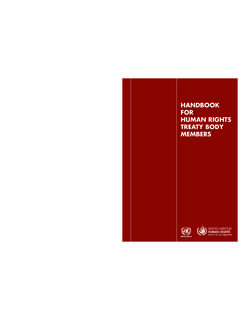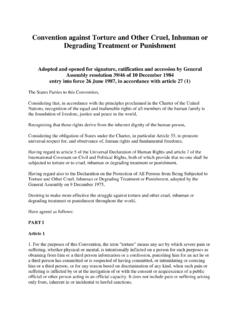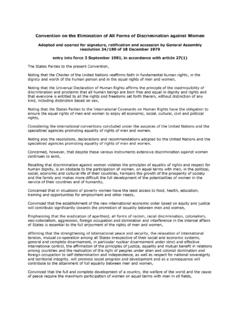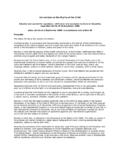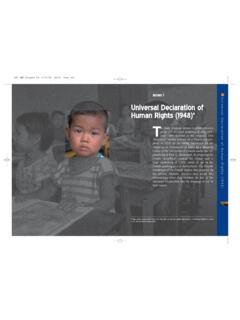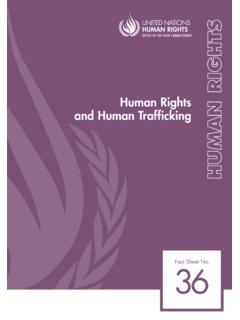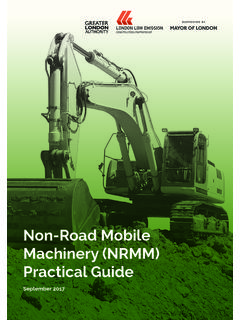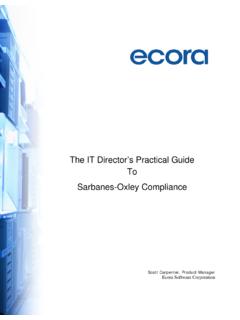Transcription of National Mechanisms for Reporting and Follow-up
1 National Mechanismsfor Reportingand follow -upA practical guide TO EFFECTIVE STATE ENGAGEMENTWITH INTERNATIONAL HUMAN RIGHTS MECHANISMSP rinted at United Nations, Geneva 1602423(E) May 2016 2,064 HR/PUB/16/1 New York and Geneva, 2016 National Mechanisms FOR Reporting AND Follow-up a practical guide to Effective State Engagement with International Human Rights MechanismsNOTEThe designations employed and the presentation of the material in this publication do not imply the expression of any opinion whatsoever on the part of the Secretariat of the United Nations concerning the legal status of any country, territory, city or area, or of its authorities, or concerning the delimitation of its frontiers or boundaries.** *Symbols of United Nations documents are composed of capital letters combined with figures. Mention of such a figure indicates a reference to a United Nations 2016 United NationsAll worldwide rights reservediiiFOREWORDThe current international human rights protection framework empowers individuals worldwide, including those that are the most marginalized and disadvantaged, to claim their rights and seek redress.
2 Since 1948 it has defined the relationship between Governments as duty bearers and individuals as rights holders shaping States responsibilities for respecting and protecting the human rights of those within their jurisdiction. This framework continues to evolve, through new treaties and new monitoring Mechanisms . This is a welcome development, as it strengthens and protects individual human rights and increases the avenues available to rights holders to seek redress. For States, Reporting and engaging with international human rights Mechanisms offers a unique opportunity for self-assessment of the situation on the ground, including through data collection and analysis, and for legislative and policy review. However, owing to the significant expansion of the system, States are faced with increasing requirements for implementing treaty obligations, Reporting to the international and regional human rights systems and following up on the recommendations or decisions emanating from them.
3 To meet these requirements, many States have increasingly adopted comprehensive, more efficient and sustainable approaches to Reporting , engagement and Follow-up through the establishment of a new type of governmental structure, known as a National mechanism for Reporting and Follow-up . States have also made public commitments to establish such Mechanisms , especially in the context of the Human Rights Council s universal periodic review. This practical guide and the accompanying Study of State Engagement with International Human Rights Mechanisms seek to identify key ingredients for awell-functioning and efficient National mechanism for Reporting and Follow-up , drawing on different State practices, while not proposing a one-size-fits-all solution. National Mechanisms for Reporting and Follow-up have the potential to become one of the key components of the National human rights protection system, bringing international and regional human rights norms and practices directly to the National level.
4 The essence of the Reporting process is nationally driven. National Mechanisms for Reporting and Follow-up build National ownership and empower line ministries, enhance human rights expertise in a sustainable manner, stimulate National dialogue, facilitate communication within the Government, and allow for structured and formalized contacts with parliament, the judiciary, National ivhuman rights institutions and civil society. Through such institutionalized contacts, the voices of victims and their representatives will also increasingly be heard. National Mechanisms for Reporting and Follow-up would furthermore enhance the coherence and impact of each State s human rights hope you will find insights and inspiration in reading this practical Guideand Ra ad Al HusseinUnited Nations High Commissioner for Human RightsvCONTENTSF oreword ..iiiIntroduction ..1I. FREQUENTLY ASKED QUESTIONS ..2Q 1. What is a National mechanism for Reporting and Follow-up ?
5 2Q 2. How do National Mechanisms for Reporting and Follow-up benefit States? ..4Q 3. What are the main types of National Mechanisms for Reporting and Follow-up ? ..5Q 4. What type of mechanism to choose? ..8Q 5. What type of mandate should a National mechanism for Reporting and Follow-up have? ..10Q 6. How should the National mechanism for Reporting and Follow-up be structured and resourced? ..10II. KEY CONDITIONS FOR AN EFFECTIVE National Engagement ..14B. Coordination ..16C. Consultation ..19D. Information management ..22 CONCLUSION ..301 INTRODUCTIONThis guide seeks to provide practical advice on the critical elements that States need to consider when establishing or strengthening their National mechanism for Reporting and Follow-up , and illustrates this advice with examples of State practice. It is based on the more comprehensive Study of State Engagement with International Human Rights Mechanisms (HR/PUB/16/1 ), which contains more detailed information on these practices.
6 The ongoing increase in ratifications, with the consequent rise in both State reports and individual complaints, as well as the growing number of special procedure mandates and related country invitations, have all led to increasingly competing requirements for States. For instance, they need to cooperate with and periodically report to all of these international human rights Mechanisms (and when applicable regional ones too), implement treaty obligations, and track and follow up the implementation of the many recommendations emanating from these international Mechanisms . Timely Reporting to these Mechanisms , as well as effective Follow-up on recommendations, benefit States. The creation of a sustainable National capacity for these tasks has become crucial to ensure that the periodic State reports are of a high quality. This will, in turn, improve the substantive quality of the interaction between the State and the international and regional human rights Mechanisms , which will then be in a position to issue tailored and implementable recommendations.
7 In order to adequately address these ever-growing, multiple and varied requirements, a rapidly increasing number of States have adopted a comprehensive, efficient approach to Reporting and Follow-up , especially by setting up a National mechanism for Reporting and Follow-up , also referred to by the abbreviation NMRF .1 Although such National Mechanisms are not entirely new, both States and the United Nations have in recent years put more focus on establishing and reinforcing such Mechanisms , in particular following the High Commissioner s 2012 report on strengthening the United Nations human rights treaty body system (A/66/860), in which their establishment was recommended. Moreover, the General Assembly, in its resolution 68/268 on strengthening and enhancing the effective functioning of the human rights treaty body system, recognizes that some States parties consider that they would benefit from improved coordination of Reporting at the National level.
8 Treaty bodies regularly emphasize that regular and timely Reporting by State 1 Previously also called standing National Reporting and coordination Mechanisms or interministerial committees/ Mechanisms on human is crucial and routinely highlight the lack of coordination and collaboration among government agencies in data collection and the inadequate technical capabilities for data collection, analysis and They also recommend that State parties ensure that an efficient division of responsibilities and Reporting is guaranteed through the establishment of effective coordination and Reporting States have also repeatedly committed themselves to establishing such Mechanisms in the context of the Human Rights Council s universal periodic review. I. FREQUENTLY ASKED QUESTIONSQ uestion 1. What is a National mechanism for Reporting and Follow-up ?A National mechanism for Reporting and Follow-up is a National public mechanism or structure that is mandated to coordinate and prepare reports to and engage with international and regional human rights Mechanisms (including treaty bodies, the universal periodic review and special procedures), and to coordinate and track National Follow-up and implementation of the treaty obligations and the recommendations emanating from these Mechanisms .
9 It may be ministerial, interministerial or institutionally National mechanism performs these functions in coordination with ministries, specialized State bodies (such as the National statistics office), parliament and the judiciary, as well as in consultation with the National human rights institution(s) and civil society. The National mechanism for Reporting and Follow-up is often based within the ministry of foreign affairs, or liaises closely with it, as this ministry is usually responsible for overseeing relations between the National public administration and the international and regional National mechanism s approach is comprehensive and it engages broadly on all human rights, with all international and regional human rights Mechanisms , and in following up on recommendations and individual communications emanating from all such human rights Mechanisms . While different in mandate, these international and regional Mechanisms are mutually reinforcing and constitute a complementary human rights protection system to State efforts at the National level.
10 Their recommendations or decisions provide the most authoritative and comprehensive overview of human rights issues 2 See, for instance, CRC/C/HUN/CO/2, para. 68, CRC/C/15 , para. 75, and CRC/C/BGD/CO/4, para. , for instance, CEDAW/C/DEN/CO/7, para. attention at the National level, based on the legal obligations under international human rights law as well as the political commitments made by States, usually in the context of the Human Rights Council or the General , a National mechanism for Reporting and Follow-up should be standing in nature and establish links across different ministries, often through a network that facilitates communication and coordination. It does not necessarily need to be a separate National mechanism is a government structure and thereby differs from a National human rights institution (NHRI), which is independent and has a mandate to promote and protect human rights at the National level and to submit recommendations to the Government.
